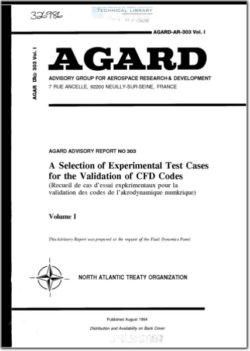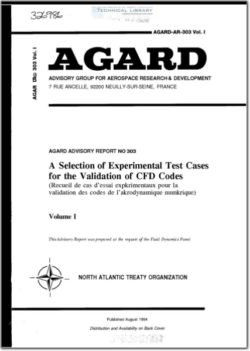AGARD-AR-303-VOL-1

- Version
- 549 Downloads
- 3.99 MB File Size
- 1 File Count
- March 8, 2016 Create Date
- March 8, 2016 Last Updated
A Selection of Experimental Test Cases for the Validation of CFD codes

Computational Fluid Dynamics (CFD) has developed to the point where the flow field around practical
aircraft and missile configurations can be described fairly realistically. Although problems related to the
numerical accuracy (grid refinement) and turbulence modeling still limit the application of these codes, their
use today is an integral part of aircraft development and design. Before a specific code can be used with
confidence, it is essential to validate the code (to test the capability of the code to describe the physics of the
flow correctly) or to calibrate the code (to establish the usefulness and reliability of the code for practical
design applications). An essential part of the validation process is a comparison of the CFD code with the
experiment.
In 1979 AGARD’s Fluid Dynamics Panel established Working Group 4 to compile a number of suitable
experiments for such a comparison. This has resulted in AGARD AR-138 (together with an Appendix
published in 1984). The Working Group limited its scope at that time to two-dimensional airfoils, slender
bodies and wing/body configurations. Some of the test cases have been used extensively in the past and are
still used today. Since the publication of AR-138, CFD methods have improved considerably. More complex
geometrical configurations with much more complex flow fields can now be calculated in fine detail. As a
result of this, detailed experiments that cover a wider range of flow types and geometries are required for
CFD validation. Many experiments that suit these needs have been made, but the results are not always
easily accessible. For that reason AGARD FDP decided in 1990 to establish another Working Group on
“The Selection of Experimental Test Cases for CFD Validation”. The first meeting of the Working Group
took place in Amsterdam in the fall of 1990 and 7 meetings later the working group members retumed to
Amsterdam for their final meeting.
In the very beginning of the Working Group, it was decided to concentrate mainly on “validation” rather
than “building block” or “calibration” experiments. Hence, the Working Group limited its scope of interest
to the flow around generic configurations of practical interest. A questionnaire was sent out to request test
cases. In total, over 100 questionnaires were retumed. Out of these, 65 were objectively selected for a more
detailed written report and subsequent evaluation by the working group members. As a result of this
evaluation, 39 test cases were selected for inclusion in this report.
| File | Action |
|---|---|
| AGARD-AR-303-VOL-1 A Selection of Experimental Test Cases for the Validation of CFD codes.pdf | Download |

Comment On This Post